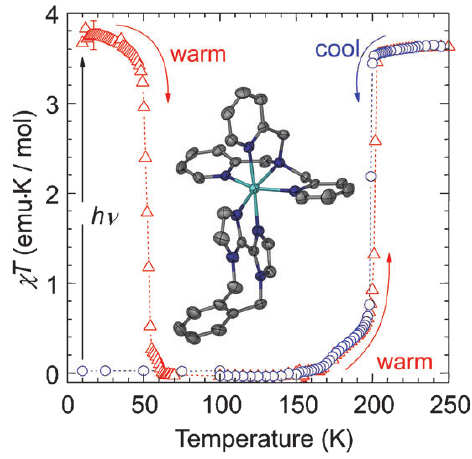
|
Photophysics and Photochemistry of Transition Metal Compounds |
| Home Research Members Collaborations Publications |

|
 |
|||||||
Three iron(II) complexes, [Fe(TPMA)(BIM)](ClO4)2⋅0.5H2O (1), [Fe(TPMA)(XBIM)](ClO4)2 (2), and [Fe(TPMA)(XBBIM)](ClO4)2 ⋅0.75CH3OH (3), were prepared by reactions of FeII perchlorate and the corresponding ligands (TPMA=tris(2-pyridylmethyl)amine, BIM=2,2′-biimidazole, XBIM=1,1′-(α,α′-o-xylyl)-2,2′-biimidazole, XBBIM=1,1′-(α,α′-o-xylyl)-2,2′-bibenzimidazole). The compounds were investigated by a combination of X-ray crystallography, magnetic and photomagnetic measurements, and Mössbauer and optical absorption spectroscopy. Complex 1 exhibits a gradual spin crossover (SCO) with T1/2=190 K, whereas 2 exhibits an abrupt SCO with approximately 7 K thermal hysteresis (T1/2=196 K on cooling and 203 K on heating). Complex 3 is in the high-spin state in the 2–300 K range. The difference in the magnetic behavior was traced to differences between the inter- and intramolecular interactions in 1 and 2. The crystal packing of 2features a hierarchy of intermolecular interactions that result in increased cooperativity and abruptness of the spin transition. In 3, steric repulsion between H atoms of one of the pyridyl substituents of TPMA and one of the benzene rings of XBBIM results in a strong distortion of the FeII coordination environment, which stabilizes the high-spin state of the complex. Both 1 and 2 exhibit a photoinduced low-spin to high-spin transition (LIESST effect) at 5 K. The difference in the character of intermolecular interactions of 1 and 2 also manifests in the kinetics of the decay of the photoinduced high-spin state. For 1, the decay rate constant follows the single-exponential law, whereas for 2 it is a stretched exponential, reflecting the hierarchical nature of intermolecular contacts. The structural parameters of the photoinduced high-spin state at 50 K are similar to those determined for the high-spin state at 295 K. This study shows that N-alkylation of BIM has a negligible effect on the ligand field strength. Therefore, the combination of TPMA and BIM offers a promising ligand platform for the design of functionalized SCO complexes. | ||||||||
 |
|
|||||||
Copper(II) complexes of the pentadentate bispidine ligands exist in two isomeric forms (see structure) with bond-length differences up to 0.5 Å. The stabilization of either isomer may be achieved by a variation of the substituent at N7. | ||||||||
|
||||||||
Incorporation of [Co(bpy)3]2+ into the cavities of the three-dimensional oxalate network structure in [Co(bpy)3][LiCr(ox)3] produces chemical pressure that destabilises the normal high-spin ground state 4T1 to such an extent that the [Co(bpy)3]2+ complex becomes a spin-crossover complex. It shows a temperature-dependent equilibrium between the 2E low-spin and the 4T1 high-spin states. | ||||||||
Download this list in format RIS
 EndNote
EndNote  BibTex
BibTex  PDF XML
PDF XML Last update Friday December 08 2017